Redundant Path Optimization in Smart Ship Software-Defined Networking and Time-Sensitive Networking Networks: An Improved Double-Dueling-Deep-Q-Networks-Based Approach
Abstract
1. Introduction
- 1.
- By integrating SDN and TSN technologies, we propose a novel network architecture for smart ship information systems.
- 2.
- We establish a switch path selection model for ship software-defined networks and design a path selection algorithm based on a D3QN and GCN, along with a ship redundant multipath selection algorithm.
- 3.
- Through simulations, we validate the convergence and effectiveness of the proposed algorithm. Experimental results indicate that the algorithm surpasses existing methods in terms of latency, packet loss, and bandwidth utilization in the simulated network topology.
2. Related Work
- A.
- Traditional Shortest Path Optimization Algorithms
- B.
- Routing Algorithms Based on Deep Learning and Machine Learning
- C.
- Routing Algorithms Based on Reinforcement Learning
- D.
- Routing Algorithms Based on DRL
3. Optimized Architecture of Ship Networks and Modeling of Switch Path Selection
3.1. Design of Optimized Architecture for Smart Ship Networks
3.1.1. Architecture of SSDTSN
3.1.2. Example of SSDTSN Topology
3.2. Modeling of Path Selection Problems
3.2.1. Parameter Definition
3.2.2. Problem Modeling
4. DRL of Redundant Multipath Selection Algorithms
4.1. Problem Description
4.2. Path Selection Algorithm Based on D3QN Fusion GCN
4.2.1. The Optimal Path Selection Process Based on D3QN
4.2.2. Optimal Path Selection Algorithm Based on D3QN Fused with GCN
4.3. Redundant Multipath Selection Algorithm for Smart Ship
4.3.1. Smart Ship Data Flow Priority Classification
4.3.2. Introduction to Redundant Multipath Selection Algorithms
| Algorithm 1 Path Selection Algorithm Based on D3QN Fusion GCN |
|
| Algorithm 2 Redundant Multipath Selection Algorithm for Smart Ships |
|
5. Experimental Evaluation
5.1. Experimental Configuration
5.2. Learning Parameter Settings
5.3. Algorithm Validation
5.4. Algorithmic Performance Evaluation
5.4.1. G-D3QN Single- and Dual-Path Performance Comparison
5.4.2. Multi-Algorithm Latency Performance Comparison
5.4.3. Multi-Algorithm Packet Loss Performance Comparison
5.4.4. Multi-Algorithm Load Performance Comparison
6. Conclusions
Author Contributions
Funding
Institutional Review Board Statement
Informed Consent Statement
Data Availability Statement
Conflicts of Interest
Abbreviations
| NMEA | National Marine Electronics Association |
| CAN | Controller Area Network |
| SDN | Software-Defined Networking |
| TSN | Time-Sensitive Networking |
| D3QN | Double Dueling Deep Q-Network |
| GCN | Graph Convolutional Network |
| API | Application Programming Interface |
| VLAN | Virtual Local Area Network |
| AIS | Automatic Identification System |
| GPS | Global Positioning System |
| SSDTSN | Ship Software-Defined Time-Sensitive Networking |
| ACO | Ant Colony Optimization |
| LSTM | Long Short-Term Memory |
| DQN | Deep Q-Network |
| DDPG | Deep Deterministic Policy Gradient |
| A2C | Advantage Actor–Critic |
| ReLU | Rectified Linear Unit |
| MSE | Mean Square Error |
| MDP | Markov Decision Process |
| OSPF | Open Shortest Path First |
| gPTP | generalized Precision Time Protocol |
References
- China Classification Society. Rules for Intelligent Ships 2024; China Classification Society: Beijing, China, 2023. [Google Scholar]
- Tran, K.; Keene, S.; Fretheim, E.; Tsikerdekis, M. Marine Network Protocols and Security Risks. J. Cybersecur. Priv. 2021, 1, 239–251. [Google Scholar] [CrossRef]
- Hao, G.; Xiao, W.; Huang, L.; Chen, J.; Zhang, K.; Chen, Y. The Analysis of Intelligent Functions Required for Inland Ships. J. Mar. Sci. Eng. 2024, 12, 836. [Google Scholar] [CrossRef]
- Yu, Z. Research on Multi-Source Heterogeneous Data Fusion Method for Intelligent Ship Navigation Test. In Proceedings of the 2023 IEEE 3rd International Conference on Data Science and Computer Application (ICDSCA), Dalian, China, 27–29 October 2023; pp. 514–516. [Google Scholar] [CrossRef]
- Tang, Y.; Shao, N. Design and Research of Integrated Information Platform for Smart Ship. In Proceedings of the 2017 4th International Conference on Transportation Information and Safety (ICTIS), Banff, AB, Canada, 8–10 August 2017; pp. 37–41. [Google Scholar] [CrossRef]
- Kim, J.; Son, J. Design of an Integrated Telecom System for Performance Enhancement on Smart Ships. J. Theor. Appl. Inf. Technol. 2021, 99. [Google Scholar] [CrossRef]
- Liu, S.; Xing, B.; Li, B.; Gu, M. Ship Information System: Overview and Research Trends. Int. J. Nav. Archit. Ocean Eng. 2014, 6, 670–684. [Google Scholar] [CrossRef]
- Prajapati, A.; Sakadasariya, A.; Patel, J. Software Defined Network: Future of Networking. In Proceedings of the 2018 International Conference on Intelligent Computing and Sustainable System (ICISS), Coimbatore, India, 19–20 January 2018; pp. 1351–1354. [Google Scholar] [CrossRef]
- Hauser, F.; Häberle, M.; Merling, D.; Lindner, S.; Gurevich, V.; Zeiger, F.; Frank, R.; Menth, M. A Survey on Data Plane Programming with P4: Fundamentals, Advances, and Applied Research. J. Netw. Comput. Appl. 2023, 212, 103561. [Google Scholar] [CrossRef]
- Xu, Y.; Shang, J.; Tang, H. Recent Trends of In-Vehicle Time Sensitive Networking Technologies, Applications and Challenges. China Commun. 2023, 20, 30–55. [Google Scholar] [CrossRef]
- Maletić, Ž.; Mlađen, M.; Ljubojević, M. A Survey on the Current State of Time-Sensitive Networks Standardization. In Proceedings of the 2023 10th International Conference on Electrical, Electronic and Computing Engineering (IcETRAN), East Sarajevo, Bosnia and Herzegovina, 5–8 June 2023; pp. 1–6. [Google Scholar] [CrossRef]
- Xu, Y.; Huang, J. A Survey on Time-Sensitive Networking Standards and Applications for Intelligent Driving. Processes 2023, 11, 2211. [Google Scholar] [CrossRef]
- Fiori, T.; Lavacca, F.; Valente, F.; Eramo, V. Proposal and Investigation of a Lite Time Sensitive Networking Solution for the Support of Real Time Services in Space Launcher Networks. IEEE Access 2024, 12, 10664–10680. [Google Scholar] [CrossRef]
- IEEE Std 802.1CB-2017; IEEE Standard for Local and Metropolitan Area Networks–Frame Replication and Elimination for Reliability. IEEE: New York, NY, USA, 2017. [CrossRef]
- Zhou, J.; Cui, G.; Hu, S.; Zhang, Z.; Yang, C.; Liu, Z.; Wang, L.; Li, C.; Sun, M. Graph Neural Networks: A Review of Methods and Applications. AI Open 2020, 1, 57–81. [Google Scholar] [CrossRef]
- Let, G.; Pratap, C.; Jagannath, D.; Dolly, D.; Evangeline, L. Software-Defined Networking Routing Algorithms: Issues, QoS and Models. Wirel. Pers. Commun. 2023, 131, 1631–1661. [Google Scholar] [CrossRef]
- Sheu, J.; Zeng, Q.; Jagadeesha, R.; Chang, Y. Efficient Unicast Routing Algorithms in Software-Defined Networking. In Proceedings of the 2016 European Conference on Networks and Communications (EuCNC), Athens, Greece, 27–30 June 2016; pp. 377–381. [Google Scholar] [CrossRef]
- Abe, J.; Mantar, H.; Yayimli, A. k-Maximally Disjoint Path Routing Algorithms for SDN. In Proceedings of the 2015 International Conference on Cyber-Enabled Distributed Computing and Knowledge Discovery, Xi’an, China, 17–19 September 2015; pp. 499–508. [Google Scholar] [CrossRef]
- Tao, J.; Shen, Y.; Yan, Y.; Wu, Y.; Zhang, Y.; Wan, J. A Distributed Heuristic Multicast Algorithm Based on QoS Implemented by SDN. In Proceedings of the 2017 3rd IEEE International Conference on Computer and Communications (ICCC), Chengdu, China, 13–16 December 2017; pp. 23–29. [Google Scholar] [CrossRef]
- Jing, S.; Muqing, W.; Yong, B.; Min, Z. An Improved GAC Routing Algorithm Based on SDN. In Proceedings of the 2017 3rd IEEE International Conference on Computer and Communications (ICCC), Chengdu, China, 13–16 December 2017; pp. 173–176. [Google Scholar] [CrossRef]
- Lin, C.; Wang, K.; Deng, G. A QoS-Aware Routing in SDN Hybrid Networks. Procedia Comput. Sci. 2017, 110, 242–249. [Google Scholar] [CrossRef]
- Owusu, A.; Nayak, A. A Framework for QoS-Based Routing in SDNs Using Deep Learning. In Proceedings of the 2020 International Symposium on Networks, Computers and Communications (ISNCC), Montreal, QC, Canada, 20–22 October 2020; pp. 1–6. [Google Scholar] [CrossRef]
- Awad, M.; Ahmed, M.; Almutairi, A.; Ahmad, I. Machine Learning-Based Multipath Routing for Software Defined Networks. J. Netw. Syst. Manag. 2021, 29, 18. [Google Scholar] [CrossRef]
- Azzouni, A.; Boutaba, R.; Pujolle, G. NeuRoute: Predictive Dynamic Routing for Software-Defined Networks. In Proceedings of the 2017 13th International Conference on Network and Service Management (CNSM), Tokyo, Japan, 26–30 November 2017; pp. 1–6. [Google Scholar] [CrossRef]
- Kato, N.; Fadlullah, Z.; Mao, B.; Tang, F.; Akashi, O.; Inoue, T.; Mizutani, K. The Deep Learning Vision for Heterogeneous Network Traffic Control: Proposal, Challenges, and Future Perspective. IEEE Wirel. Commun. 2016, 24, 146–153. [Google Scholar] [CrossRef]
- Shakya, A.; Pillai, G.; Chakrabarty, S. Reinforcement Learning Algorithms: A Brief Survey. Expert Syst. Appl. 2023, 231, 120495. [Google Scholar] [CrossRef]
- Szepesvári, C. Markov Decision Processes. In Algorithms for Reinforcement Learning; Springer International Publishing: Cham, Switzerland, 2010; pp. 1–10. [Google Scholar] [CrossRef]
- Hassen, H.; Meherzi, S.; Jemaa, Z. Improved Exploration Strategy for Q-Learning Based Multipath Routing in SDN Networks. J. Netw. Syst. Manag. 2024, 32, 25. [Google Scholar] [CrossRef]
- Rischke, J.; Sossalla, P.; Salah, H.; Fitzek, F.; Reisslein, M. QR-SDN: Towards Reinforcement Learning States, Actions, and Rewards for Direct Flow Routing in Software-Defined Networks. IEEE Access 2020, 8, 174773–174791. [Google Scholar] [CrossRef]
- Casas-Velasco, D.; Rendon, O.; da Fonseca, N. Intelligent Routing Based on Reinforcement Learning for Software-Defined Networking. IEEE Trans. Netw. Serv. Manag. 2020, 18, 870–881. [Google Scholar] [CrossRef]
- Wang, H.; Liu, N.; Zhang, Y.; Feng, D.; Huang, F.; Li, D.; Zhang, Y. Deep Reinforcement Learning: A Survey. Front. Inf. Technol. Electron. Eng. 2020, 21, 1726–1744. [Google Scholar] [CrossRef]
- Liu, W.; Cai, J.; Chen, Q.; Wang, Y. DRL-R: Deep Reinforcement Learning Approach for Intelligent Routing in Software-Defined Data-Center Networks. J. Netw. Comput. Appl. 2021, 177, 102865. [Google Scholar] [CrossRef]
- Xia, D.; Wan, J.; Xu, P.; Tan, J. Deep Reinforcement Learning-Based QoS Optimization for Software-Defined Factory Heterogeneous Networks. IEEE Trans. Netw. Serv. Manag. 2022, 19, 4058–4068. [Google Scholar] [CrossRef]
- Jinesh, N.; Shinde, S.; Narayan, D. Deep Reinforcement Learning-Based QoS Aware Routing in Software Defined Networks. In Proceedings of the 2023 14th International Conference on Computing Communication and Networking Technologies (ICCCNT), Delhi, India, 6–8 July 2023; pp. 1–6. [Google Scholar] [CrossRef]
- Gayatri Shivani, M.; Subba Rao, S.; Sujatha, C. A Survey on Deep Recurrent Q Networks. In Intelligent Systems and Machine Learning; Nandan Mohanty, S., Garcia Diaz, V., Satish Kumar, G., Eds.; Springer: Cham, Switzerland, 2023; pp. 251–261. [Google Scholar] [CrossRef]
- Özalp, R.; Varol, N.; Taşci, B.; Uçar, A. A Review of Deep Reinforcement Learning Algorithms and Comparative Results on Inverted Pendulum System. In Machine Learning Paradigms: Advances in Deep Learning-Based Technological Applications; Tsihrintzis, G., Jain, L., Eds.; Springer: Cham, Switzerland, 2020; pp. 237–256. [Google Scholar] [CrossRef]
- Aslam, S.; Michaelides, M.; Herodotou, H. Internet of Ships: A Survey on Architectures, Emerging Applications, and Challenges. IEEE Internet Things J. 2020, 7, 9714–9727. [Google Scholar] [CrossRef]
- Amin, M.; Othman, M. Re-Exploration of ϵ-Greedy in Deep Reinforcement Learning. In RiTA 2020. Lecture Notes in Mechanical Engineering; Chew, E., Majeed, A.P.P.A., Liu, P., Platts, J., Myung, H., Kim, J., Kim, J.-H., Eds.; Springer: Singapore, 2021. [Google Scholar] [CrossRef]
- Wang, Z.; Schaul, T.; Hessel, M.; Van Hasselt, H.; Lanctot, M.; De Freitas, N. Dueling Network Architectures for Deep Reinforcement Learning. In Proceedings of the 33rd International Conference on Machine Learning, New York, NY, USA, 20–22 June 2016; pp. 1995–2003. [Google Scholar]
- Luong, N.; Hoang, D.; Gong, S.; Niyato, D.; Wang, P.; Liang, Y.C.; Kim, D. Applications of Deep Reinforcement Learning in Communications and Networking: A Survey. IEEE Commun. Surv. Tutorials 2019, 21, 3133–3174. [Google Scholar] [CrossRef]
- Jiang, F.; Li, Y.; Sun, C.; Wang, C. Dueling Double Deep Q-Network Based Computation Offloading and Resource Allocation Scheme for Internet of Vehicles. In Proceedings of the 2023 IEEE Wireless Communications and Networking Conference (WCNC), Glasgow, UK, 26–29 March 2023; pp. 1–6. [Google Scholar] [CrossRef]
- Igual, L.; Seguí, S. Network Analysis. In Introduction to Data Science: A Python Approach to Concepts, Techniques and Applications; Springer International Publishing: Cham, Switzerland, 2024; pp. 151–174. [Google Scholar] [CrossRef]
- Yang, L.; Wei, Y.; Yu, F.; Han, Z. Joint Routing and Scheduling Optimization in Time-Sensitive Networks Using Graph-Convolutional-Network-Based Deep Reinforcement Learning. IEEE Internet Things J. 2022, 9, 23981–23994. [Google Scholar] [CrossRef]
- Xu, J.; Wang, Y.; Zhang, B.; Ma, J. A Graph Reinforcement Learning Based SDN Routing Path Selection for Optimizing Long-Term Revenue. Future Gener. Comput. Syst. 2024, 150, 412–423. [Google Scholar] [CrossRef]
- Fujimoto, R.; Riley, G.; Perumalla, K. Wire–Line Network Simulation. In Network Simulation; Springer International Publishing: Cham, Switzerland, 2007; pp. 19–25. [Google Scholar] [CrossRef]
- Mishra, P. Introduction to Neural Networks Using PyTorch. In PyTorch Recipes: A Problem-Solution Approach to Build, Train and Deploy Neural Network Models; Apress: Berkeley, CA, USA, 2023; pp. 117–133. [Google Scholar] [CrossRef]
- Nie, M.; Chen, D.; Wang, D. Reinforcement Learning on Graphs: A Survey. IEEE Trans. Emerg. Top. Comput. Intell. 2023, 7, 1065–1082. [Google Scholar] [CrossRef]
- Chen, G.; Sun, J.; Zeng, Q.; Jing, G.; Zhang, Y. Joint Edge Computing and Caching Based on D3QN for the Internet of Vehicles. Electronics 2023, 12, 2311. [Google Scholar] [CrossRef]
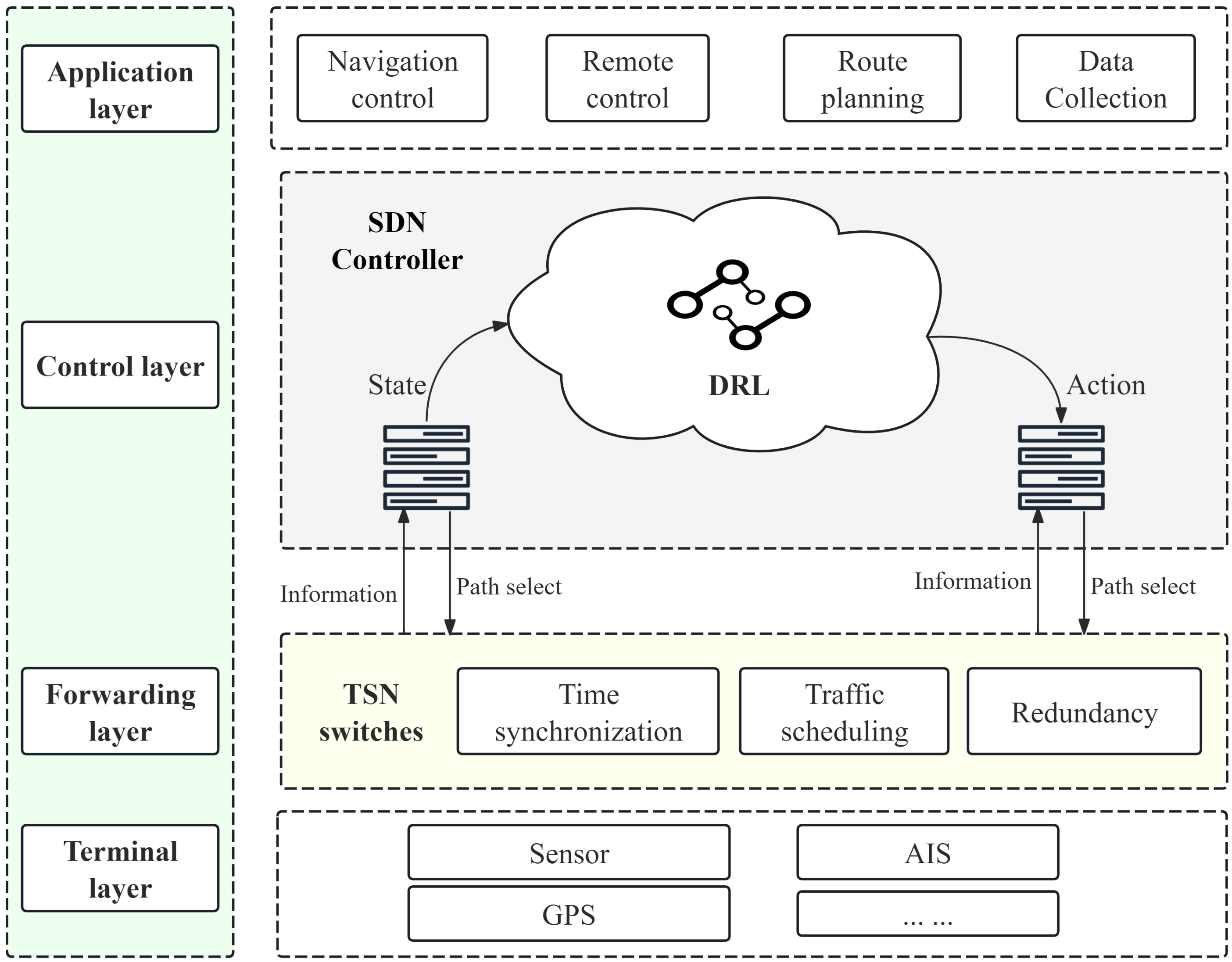
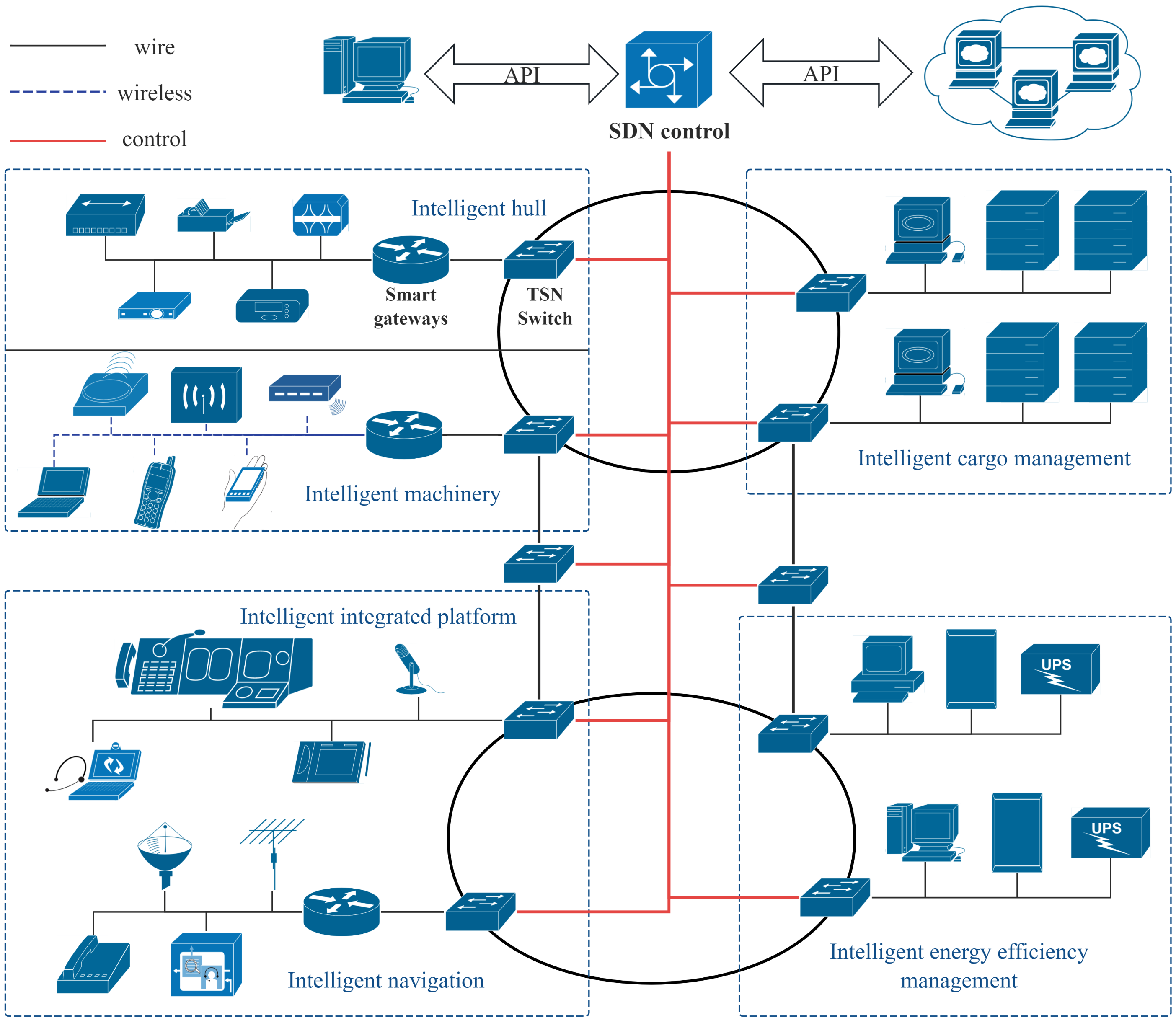

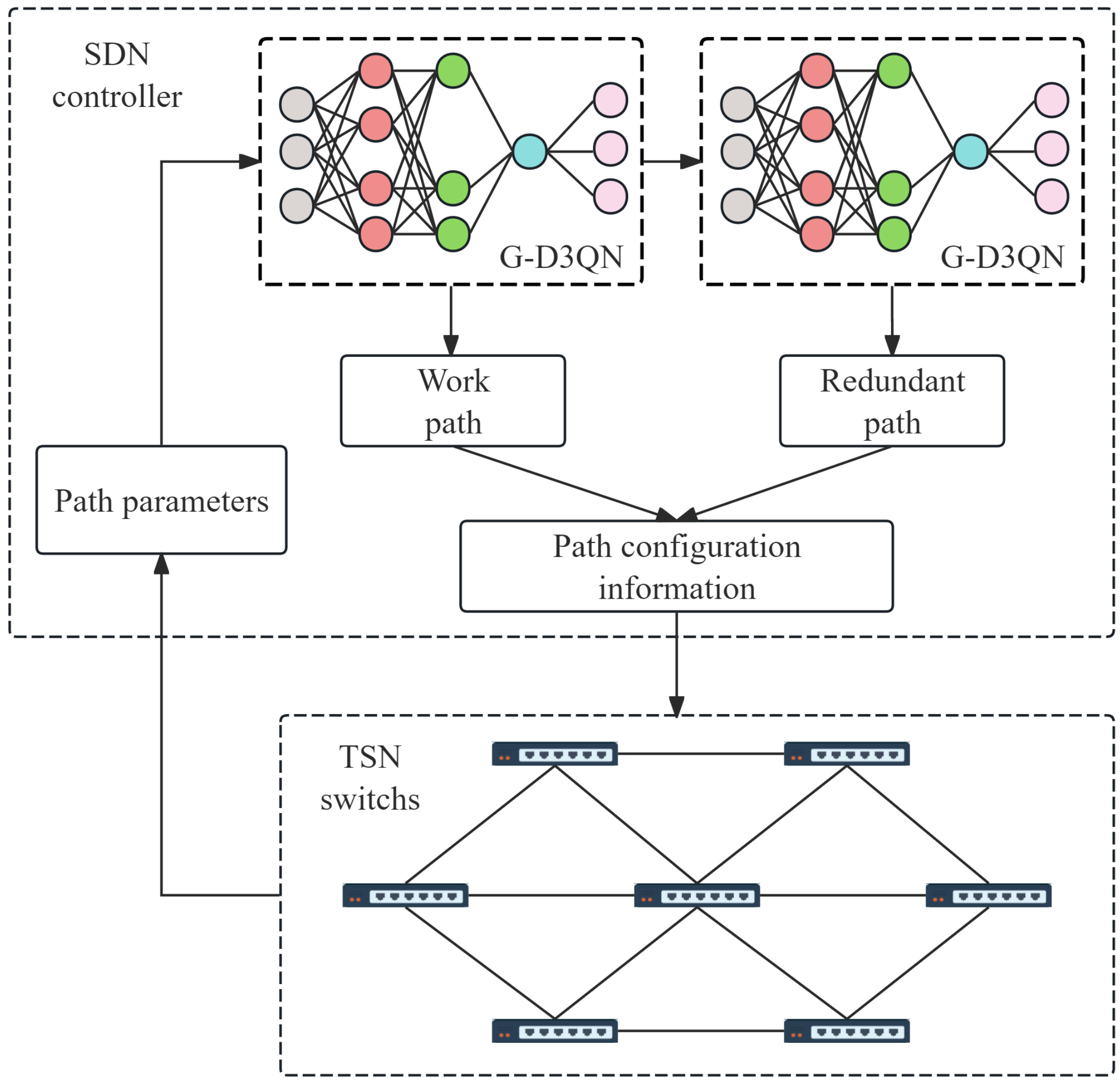

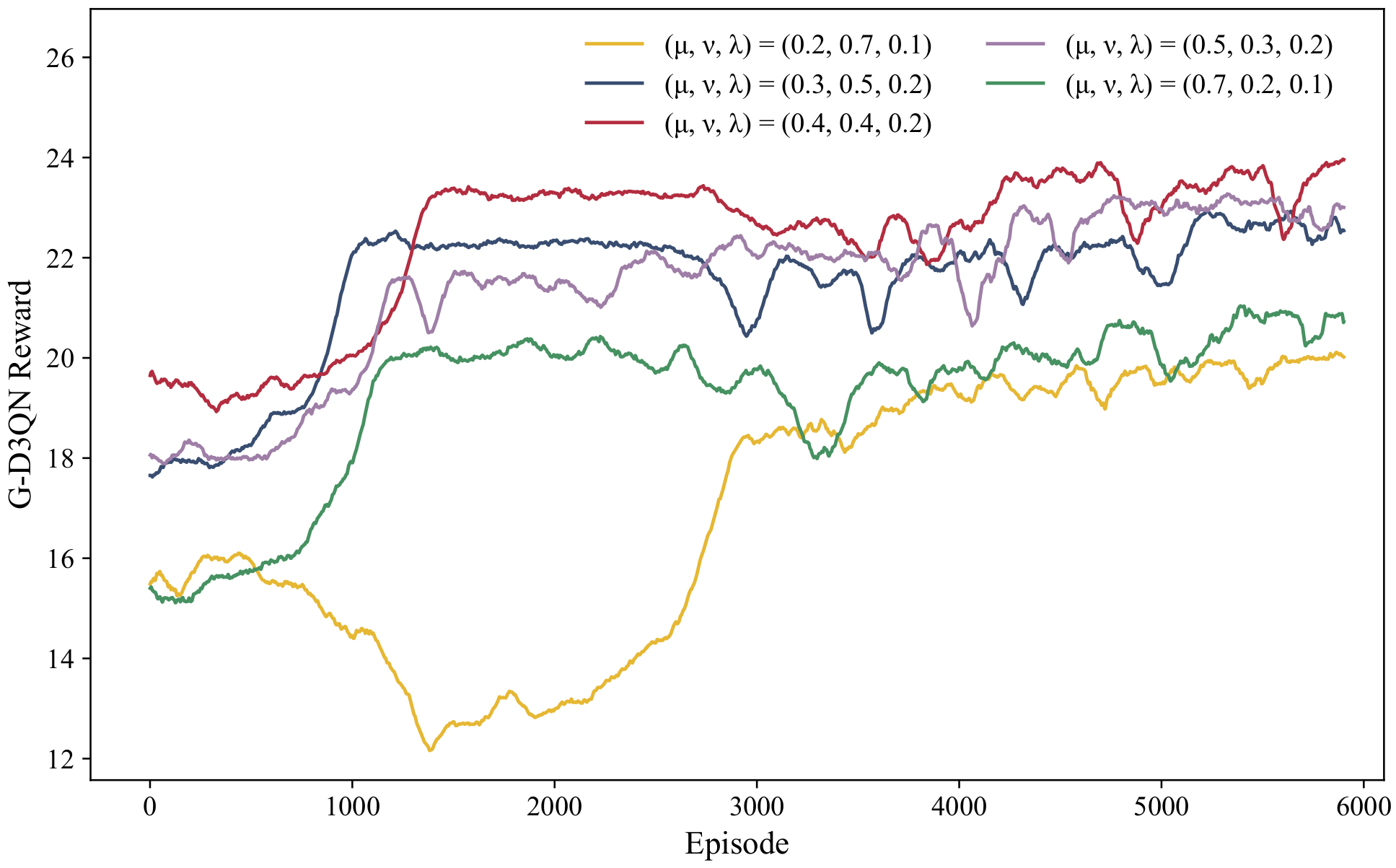


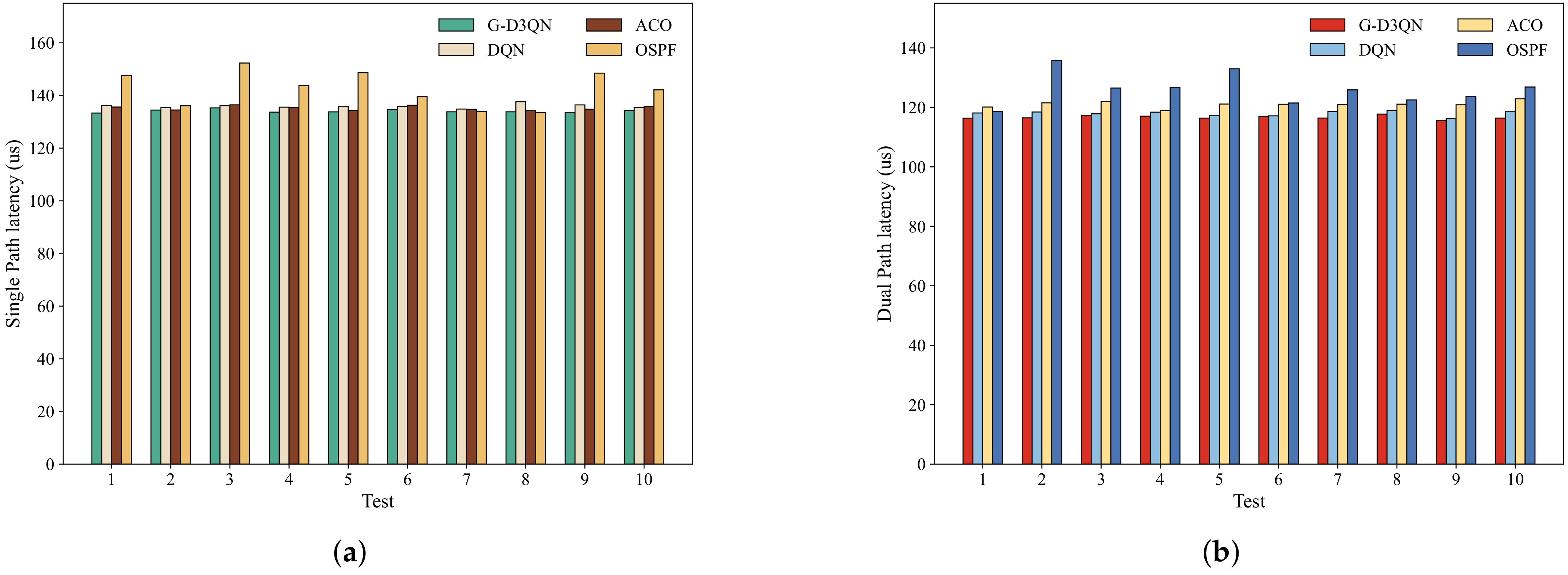
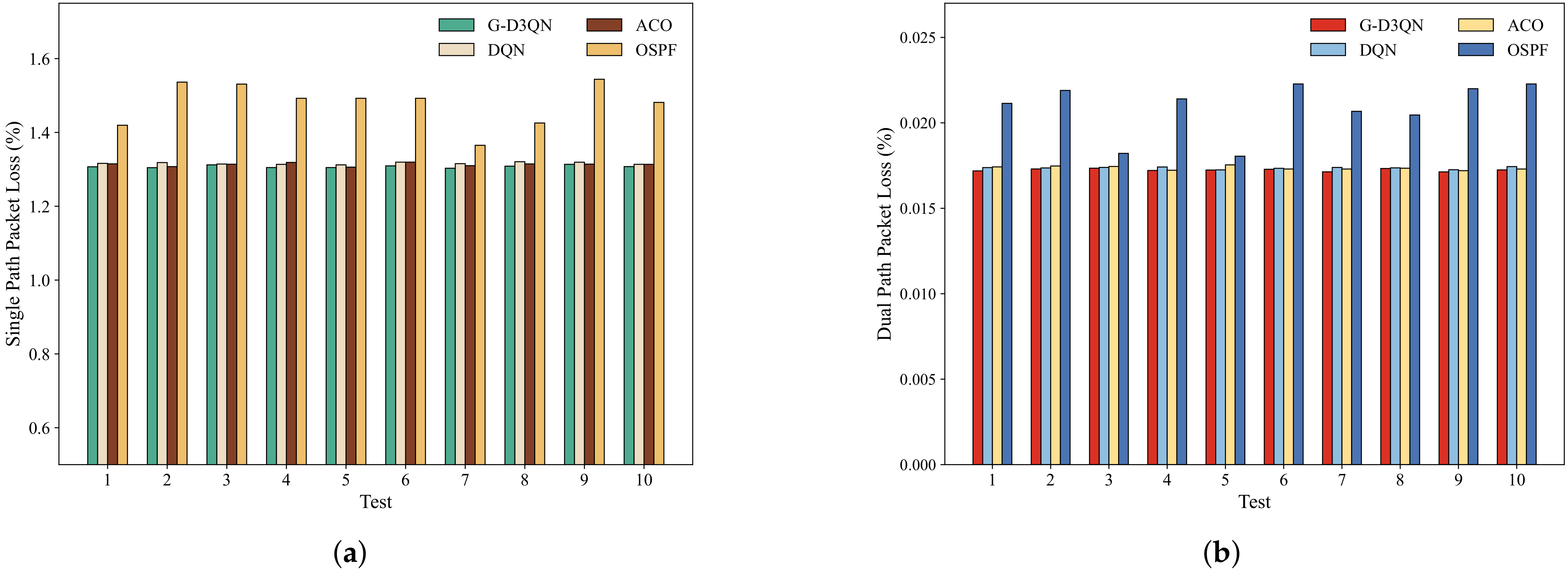
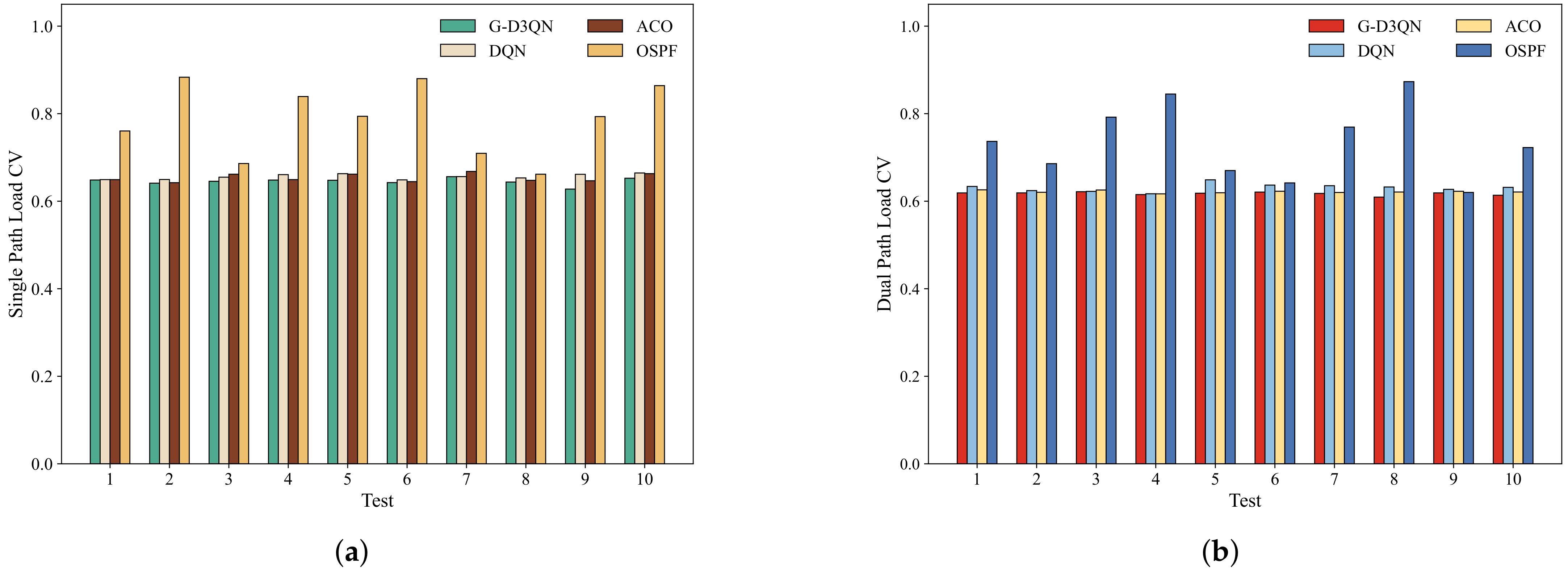
| Notation | Definition |
|---|---|
| Data flow | |
| P | End-to-end transmission path |
| Transmission links of flow at time t | |
| Transmission latency of flow at time t | |
| Average transmission latency of J data flows | |
| Used bandwidth including the number of bytes received and sent during statistical time | |
| B | Total path bandwidth |
| Average bandwidth utilization of J data flows | |
| Bandwidth load coefficient of variation | |
| The packet loss rate of transmission path for | |
| Average packet loss rate of J data flows |
| Data | Type | Cycle | Requirements | Reliability | Priority |
|---|---|---|---|---|---|
| Navigation data transmission: real-time radar and AIS info | Isochronous | 50 µs–2 ms | Strict time limit, real-time | High | High |
| Engine control and monitoring: engine parameters, power system control signals | Cyclic Sync | 100 µs–2 ms | Max latency, real time | High | High |
| Safety alarm system: fire, leakage, emergency stop notifications | Alarms/Events | Async/sudden | Max latency, real time | High | High |
| Sensor data collection: environmental sensors, equipment status | Cyclic Async | 2–20 ms | Max latency | High | Medium |
| System configuration and maintenance: equipment parameters, fault diagnostics | Config/Diag | Async/sudden | Bandwidth | Medium | Medium |
| Network management and device control: topology management, start/stop instructions | Network control | Cyclic | Bandwidth | High | Medium |
| Non-critical communication: crew chat, non-critical data | Best Effort | Async/sudden | None | Low | Low |
| Surveillance video transmission: surveillance cameras, entertainment system | Video | Async/sudden | Max latency | Low | Low |
| Voice communication: intercom system, public broadcasting | Audio/Voice | Async/sudden | Max latency | Low | Low |
| Parameter | Value |
|---|---|
| Learning rate | 0.1, 0.01, 0.001, 0.0001 |
| Training times | 6000 |
| Batch size (D3QNAgent) | 512 |
| discount factor | 0.99 |
| Experience cache area | 20,000 |
| -greedy | Initial 1.0, decay rate 0.999, minimum 0.01 |
| (0.2, 0.7, 0.1), (0.3, 0.5, 0.2), (0.4, 0.4, 0.2), (0.5, 0.3, 0.2), (0.7, 0.2, 0.1) |
| Method | Single-Path Average Time Latency (µs) | Dual-Path Average Time Latency (µs) | Single-Path Average Packet Loss Rate (%) | Dual-Path Average Packet Loss (%) | Single-Path Load CV | Dual-Path Load CV |
|---|---|---|---|---|---|---|
| D3QN | 134.0661 | 116.8674 | 1.3075 | 0.01726 | 0.6454 | 0.6174 |
| DQN | 135.9177 | 117.9687 | 1.3163 | 0.01736 | 0.6562 | 0.6310 |
| ACO | 135.2319 | 121.2392 | 1.3133 | 0.01735 | 0.6535 | 0.6216 |
| OSPF | 142.9973 | 126.5977 | 1.4780 | 0.02074 | 0.7872 | 0.7356 |
Disclaimer/Publisher’s Note: The statements, opinions and data contained in all publications are solely those of the individual author(s) and contributor(s) and not of MDPI and/or the editor(s). MDPI and/or the editor(s) disclaim responsibility for any injury to people or property resulting from any ideas, methods, instructions or products referred to in the content. |
© 2024 by the authors. Licensee MDPI, Basel, Switzerland. This article is an open access article distributed under the terms and conditions of the Creative Commons Attribution (CC BY) license (https://creativecommons.org/licenses/by/4.0/).
Share and Cite
Xu, Y.; He, S.; Zhou, Z.; Xu, J. Redundant Path Optimization in Smart Ship Software-Defined Networking and Time-Sensitive Networking Networks: An Improved Double-Dueling-Deep-Q-Networks-Based Approach. J. Mar. Sci. Eng. 2024, 12, 2214. https://doi.org/10.3390/jmse12122214
Xu Y, He S, Zhou Z, Xu J. Redundant Path Optimization in Smart Ship Software-Defined Networking and Time-Sensitive Networking Networks: An Improved Double-Dueling-Deep-Q-Networks-Based Approach. Journal of Marine Science and Engineering. 2024; 12(12):2214. https://doi.org/10.3390/jmse12122214
Chicago/Turabian StyleXu, Yanli, Songtao He, Zirui Zhou, and Jingxin Xu. 2024. "Redundant Path Optimization in Smart Ship Software-Defined Networking and Time-Sensitive Networking Networks: An Improved Double-Dueling-Deep-Q-Networks-Based Approach" Journal of Marine Science and Engineering 12, no. 12: 2214. https://doi.org/10.3390/jmse12122214
APA StyleXu, Y., He, S., Zhou, Z., & Xu, J. (2024). Redundant Path Optimization in Smart Ship Software-Defined Networking and Time-Sensitive Networking Networks: An Improved Double-Dueling-Deep-Q-Networks-Based Approach. Journal of Marine Science and Engineering, 12(12), 2214. https://doi.org/10.3390/jmse12122214







